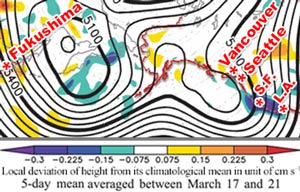記事元
Study: Global consequences from Fukushima-like nuclear disaster; Many nations at risk of ‘great exposure’ — Transport of hot particles to US was especially effective during worst releases after reactor explosions — Radioactivity confined ‘close to surface’ due to seasonal factors (VIDEO)
研究:福島のような原子力災害からの全世界的結果。「膨大な被曝」の危険性のある多くの国家 — 米国へのホットパーティクル(熱粒子)の輸送は、原子炉の爆発後の最悪放出時に特に効果的であった -
放射能は季節要因により「表面近くに」閉じ込められた(動画)
Published: January 28th, 2015 at 12:10 pm ET By ENENews
公開:2015年1月28日、午後0:10 ET ENENewsによる
T. Christoudias and Y. Proestos of The Cyprus Institute, J. Lelieveld of Max Planck Institute of Chemistry (Germany), Dec 12, 2014 (emphasis added):
キプロス研究所のT. クリストディアス、マックスプランク化学研究所のJ. レリーフェルト(ドイツ)およびY. プロエストス、2014年12月12日(強調は記者):
We estimate the contamination risks from the atmospheric dispersion of radionuclides released by severe nuclear power plant accidents… We present an overview of global risks… [These] risks exhibit seasonal variability, with the highest surface level concentrations of gaseous radionuclides in the Northern Hemisphere during winter [Fukushima crisis began with 10 days left in winter].
我々は、深刻な原子力発電所の事故により放出される放射性核種の大気拡散による汚染のリスクを推定する...
我々は全世界的リスクの概要を提示する... [これらの]リスクは、冬の間に北半球でガス状の放射性核種の最高レベルの表面濃度の季節変動を表す[福島の危機は、冬を10日間残して始まった。]
The model setup was evaluated… using emission estimates from… Fukushima
モデルの設定が評価された...排出量推定値を使用して...福島
The risk posed from nuclear power plant accidents is not limited to the national or even regional level, but can assume global dimensions. Many nations may be subjected to great exposure after severe accidents.
原子力発電所事故からもたらされるリスクは国家あるいは地域レベルに限定されるものではなく、全世界的な次元であると推測される。多くの国が、過酷事故の後に莫大な被曝を被(こうむ)るであろう。
Our model shows increased surface-level concentrations throughout the Northern Hemisphere during the boreal winter months compared to the summer… Not only the expected risk magnitude is higher, but the geographical extent of the high concentrations of transported radionuclides is more pronounced towards the north… Horizontal advection [i.e. transfer] is more efficient in winter due to relatively stronger winds, and the concentrations are highest near the surface [and] surface level concentrations in the summer tend to be more localized in the emission region.
我々のモデルは、夏に比べ北方の冬の間に、北半球全体で表面の濃度レベル増大を示す...予想リスクの大きさが高くなるだけでなく、輸送された放射性核種が高濃度な地理的範囲は、北に向かっていると断言される...水平移流[すなわち転送]は、比較的強い風のために冬に、より効率的である、そしてその濃度は表面近くで最も高い[そして]夏の表面の濃度レベルは、放射(能が広がっている)領域内でより局所的になる傾向がある。
Our results illustrate that accidents… could have significant trans-boundary consequences. The risk estimate [shows] increased surface level concentrations of gaseous radionuclides in the Northern Hemisphere during winter and a larger geographical extent towards the north and the east… This is related to the relatively shallow boundary layer in winter that confines the emitted radioactivity to the lowest part of the atmosphere close to the surface…It is the view of the authors that it is imperative to assess the risks from the atmospheric dispersion of radioactivity from potential NPP accidents [for] emergency response planning on national and international levels.
我々の結果は、事故が...重要な越境の結果をもたらす可能性があることを示している。リスク推定は、北半球で冬の間、ガス状の放射性核種の表面濃度レベルの増加と、北と東に向かって、より大きな地理的範囲を[示している]...これは、冬の比較的浅い境界層に関連している、その境界層は、表面に近い大気の最下部に放出された放射能を閉じ込める...著者の見解であるが、潜在的な原子力発電所事故による放射能の大気拡散から、国内および国際レベルで計画する緊急対応[のための] リスクを評価することが不可欠である。

JAMSTEC, Univ. of Tokyo, etc.: We show a numerical simulation for the long-range transport from the [Fukushima] plant to the US… Large-scale updraft [over] Japan from March 14 to 15 was found effective in lifting the particles [to the] jet stream that could carry the particles across the Pacific within 3 to 4 days [See study: On Mar. 15, Fukushima reactors emitted 100 quadrillion Bq of cesium into air — This one day was equal to total lifetime release from Chernobyl]… Some of the particles [had a] long-range atmospheric transport over — 10,000 km within 3 to 4 days… [R]adioactive materials were detected in that period over the east and west coasts of the U.S… In order for the particles to be transported with the jet stream, they must be lifted up from the surface boundary layer to the mid- or upper troposphere. Large-scale updraft was indeed observed… on March 14 through 15… [T]he westerlies in mid-March were thus particularly effective in the trans-Pacific transport of the radioactive materials…
独立行政法人海洋研究開発機構 (JAMSTEC) 、東京大学、他:我々は[福島]原発からの長距離輸送のための数値シミュレーションを示す... 3月14日から15日にかけて、3〜4日以内に、粒子を太平洋の渡って運ぶことができるジェットストリーム[まで]粒子を持ち上げるのに有効な日本[上空の]大規模な上昇気流が分かった。[研究を参照: 3月15日に福島の原子炉は、空気中にセシウム100兆ベクレルを放出 — この1日はチェルノブイリからの総放出量]に等しかった...粒子の一部は長距離大気輸送[された] — 3~4日以内に1万キロ...[放]放射性物質の素材は、その期間中に米国の東西海岸上に検出された...粒子がジェットストリームで搬送されるためには、それらが中・上対流圏まで表面境界層から持ち上げられる必要があります。大規模上昇気流が実際に3月14日から15日にかけて...観察された...3月中旬の[偏]西風は、このように放射性物質の太平洋横断輸送に特に有効であった...
Watch the numerical plume simulation here
数字で表したプルームのシミュレーションをここで見る
http://www.asyura2.com/14/genpatu41/msg/748.html
 題名には必ず「阿修羅さんへ」と記述してください。
題名には必ず「阿修羅さんへ」と記述してください。